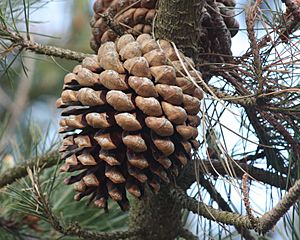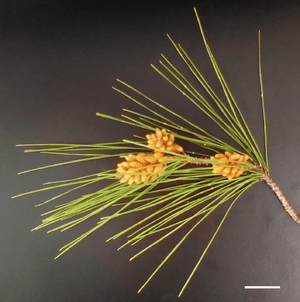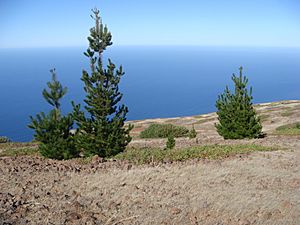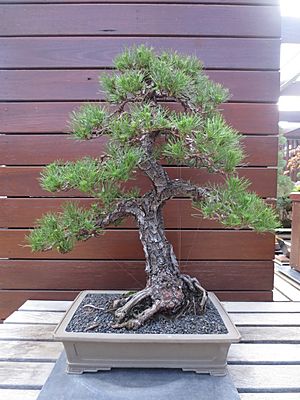Monterey pine facts for kids
Quick facts for kids Monterey pine |
|
|---|---|
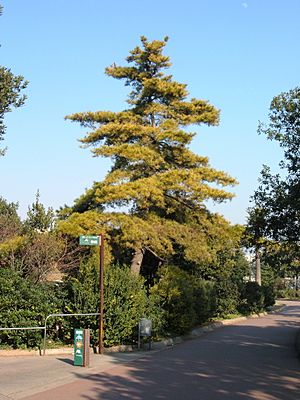 |
|
| Conservation status | |
| Scientific classification | |
| Genus: |
Pinus
|
| Species: |
radiata
|
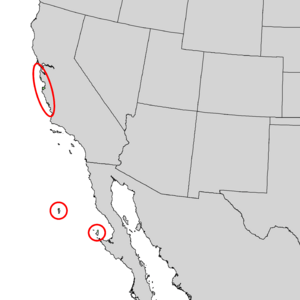 |
|
| Natural range of Pinus radiata | |
The Monterey pine (also called Pinus radiata, insignis pine, or radiata pine) is a type of pine tree. It grows naturally along the Central Coast of California and on two islands off Mexico: Guadalupe Island and Cedros Island. This tree is an evergreen conifer, meaning it keeps its needles all year round and produces cones. It belongs to the Pinaceae family.
Monterey pine is a very useful tree. It grows quickly and produces medium-density wood. People have studied and grown this tree for over a hundred years. It is now the most widely planted pine tree in the world. This is because it grows fast and its wood is good for lumber (wood for building) and pulp (for paper).
Even though it's planted a lot around the world, the Monterey pine faces big problems where it grows naturally. A disease called pine pitch canker (caused by a fungus called Fusarium circinatum) is a serious threat to these native trees.
Contents
Where Monterey Pines Grow
Monterey pines are native to only a few small areas in California. These areas are in Santa Cruz, Monterey, and San Luis Obispo Counties. There are also special types (called varieties) of this pine on two Mexican islands. One is called Pinus radiata var. binata or Guadalupe pine on Guadalupe Island. Another type, P. radiata var. cedrosensis, might grow on Cedros Island. Both islands are in the Pacific Ocean, off the coast of Baja California.
This pine has been planted in many other countries. It is the main introduced tree in Australia, New Zealand, and Spain. It is also a major plantation tree in Argentina, Chile, Uruguay, Kenya, and South Africa. You can even find it on Tristan da Cunha, which is one of the most remote inhabited islands in the world!
What Monterey Pines Look Like
The Monterey pine is a coniferous evergreen tree. In the wild, it usually grows to be about 15 to 30 meters (50 to 100 feet) tall. But in places where it is grown, it can reach up to 60 meters (200 feet)! Its branches point upwards, and the top of the tree is usually rounded.
The leaves of the Monterey pine are called "needles." They are bright green and grow in groups of three. Each needle is slender, about 8 to 15 centimeters (3 to 6 inches) long, and has a blunt tip. However, the variety binata has needles in groups of two.
The female cones are 7 to 17 centimeters (3 to 7 inches) long. They are brown and egg-shaped. These cones often sit unevenly on a branch, attached at an angle. The bark of the tree is dark grey to brown and has cracks in it. Monterey pines can live for 80 to 90 years if they are not affected by disease or harvesting.
The name radiata comes from the cracks that spread out from the center of the cone scales. This tree is related to the Bishop pine and knobcone pine. It can even mix with them to form hybrids. You can tell it apart because its needles grow in threes (not pairs like the Bishop pine). Also, its cones do not have sharp spines on their scales, which helps tell it apart from both.
Modern Monterey pines grown in plantations look very different from the wild trees. Thanks to careful breeding, trees planted since the 1990s have very straight, tall trunks. They are also pruned so that the bottom two-thirds of a mature tree have no branches. This means the wood from these parts is free of knots.
How Monterey Pines Live in Nature

Monterey pines are good at surviving forest fires. Their cones are "serotinous," which means they stay closed until the heat from a fire opens them. After a fire, the many seeds inside are released. This helps new trees grow on the burned forest floor. Sometimes, the cones can also open on very hot days.
In its natural home, the Monterey pine lives with specific plants and animals. It is often found growing with the Cupressus macrocarpa tree in coastal Monterey County, California. One pine forest in Monterey, California, is where the rare and endangered Hickman's potentilla plant was first found. Another rare orchid called Piperia yadonii also grows only in a pine forest near Pebble Beach, California. In its native areas, the Monterey pine is a main host for a dwarf mistletoe called Arceuthobium littorum.
A group of Monterey pines in Pacific Grove, California is an important place for monarch butterflies to spend the winter.
In South Africa, where it is not native, the Monterey pine uses a lot of water. Its roots can grow very deep, sometimes up to 12 meters (40 feet) long! Because of this, removing large numbers of these non-native trees in South Africa has helped increase the amount of available water.
Protecting Monterey Pines
Threats from Fungal Disease
The three remaining wild groups of Monterey pines in California are in danger. A fungal disease called pine pitch canker (Fusarium circinatum) is infecting and killing them. This disease comes from the southeastern United States and was found in California in 1986. When trees start to die from the disease, they attract bark beetles. These beetles then help spread the infection to other trees. In some areas, 80–90% of the trees are infected. If this disease spreads to countries that rely on Monterey pine plantations, like New Zealand, it could cause huge problems.
Another disease, Sphaeropsis blight (Diplodia pinea), also infects Monterey pines in California. It causes serious damage to plantations in New Zealand, Australia, and South Africa, especially after hail storms damage the growing tips of the trees.
Challenges in Baja California
On Guadalupe Island, the variety binata is critically endangered. For many years, tens of thousands of feral goats ate the young binata seedlings and caused soil erosion. By 2001–2002, only about one hundred older trees were left. However, a program to remove the goats was mostly finished by 2005. Since then, hundreds of young Guadalupe pines have started to grow in areas that were fenced off after 2001. This is the first time new growth has been seen in about 150 years! The biggest threat now to the Guadalupe Island pine is the possible accidental introduction of pine pitch canker. The University of California has a research station that helps protect the binata variety by growing seedlings from Guadalupe Island.
How Monterey Pines Are Grown
In Australia
The Monterey pine was brought to Australia in the 1870s. It is now the most common tree in Australian plantations. Some Australians worry about this because it means less natural habitat for native wildlife. Outside of plantations, this tree is often seen as an environmental weed in southeastern and southwestern Australia. People are encouraged to remove individual trees that grow outside of planted areas. In Sydney, there is a forest of introduced Monterey pines on Prospect Hill in the suburb of Pemulwuy.
In Chile
In Chile, large areas of Monterey pine plantations have replaced the native Valdivian temperate rain forests. This has changed the natural forests. In 2001, Monterey pine produced 5,580,724 cubic meters of lumber in Chile. This was 95% of all the lumber produced in the country!
In New Zealand
The Monterey pine (always called Pinus radiata in New Zealand) was first brought to New Zealand in 1859. Today, 89% of the country's planted forests are made up of this tree. This includes the Kaingaroa Forest, which is one of the largest planted forests in the world. Large-scale planting became common around 1900 in the Rotorua area, where prison workers helped plant the trees. In some places, it is considered an invasive species (called a wilding conifer or wilding pine) because it has spread from plantations into natural areas. It is the most widely used wood in New Zealand.
Using pine for building houses did not become common until World War II, when other wood was scarce. It had been used in the Southland area since about 1920. However, some people still doubted its quality as late as 1945. Experiments with treating the wood to preserve it started in 1943.
In Spain
In the Iberian Peninsula, Monterey pines were introduced in the 1800s. They were mainly planted in the northern areas to use their wood for paper pulp and for supports in coal mines. You can find them in lower areas of Galicia, Asturias, Cantabria, the Basque Country, and in the north of the Canary Islands.
Monterey pine forests can have a negative effect on the local environment. In these plantations, there are usually no other tree species. The shade from the pines also prevents other plants from growing well underneath. About 13% of the wood cut each year in Spain comes from this pine.
In the United States
The Monterey pine is often planted in private gardens and public parks in California and other places with similar climates. It is especially common as a landscape tree in coastal California, where the weather is much like its native home. It grows quickly and can adapt to many different soil types and climates. However, it does not like temperatures below about -15°C (5°F). Its fast growth makes it great for landscaping and forestry. In good conditions, a Monterey pine can reach its full height in about 40 years. While natural factors determine where it grows, people have greatly expanded its range along the California coast.
Uses of Monterey Pine Wood
Monterey pine wood is useful for many things. It has a pleasant, resinous smell when you work with it. It holds screws and nails well and can be painted or stained easily. Modern kiln-dried timber is also very easy to work with. It is about one-third heavier than dried western red cedar. However, it can be brittle when bent, so it's not as strong for holding heavy loads as Oregon pine (Douglas fir).
Monterey pine is used in house construction for things like weatherboards, posts, beams, or plywood. It's also used for fences, retaining walls, and concrete forms. Sometimes, untreated plywood is used in boat building, but it needs to be covered in epoxy resin to keep out moisture.
The wood is usually dried in a kiln to 12% moisture. It comes in long, clear pieces. You can get it treated with special chemicals or untreated. Chemical treatments are very effective. Treated timber is often used in the ground for posts and poles in structures like retaining walls. This treated wood is sometimes called "tanalized wood." Different treatment levels (H1, H2, H3, H4, H5) are used for different purposes, from indoor use to in-ground use.
Lower quality timber is turned into pulp to make newsprint (paper for newspapers). Higher quality timber is used for building houses. Monterey pine wood can also be chipped to make particle board sheets, which are often used for flooring. Other sheet products include hardboard, softboard, and plywood. Most plywood is for building and comes in different thicknesses. A small amount of higher quality plywood is used for furniture, cabinets, and boat building. This type of plywood is free of knots and cracks and is glued with waterproof glue. Since the 1990s, special "finger-jointed" wood has also become available. This wood is made by joining smaller pieces together and can be very long.
In 1958, a New Zealand boat designer named Des Townson built 186 small sailboats called Zephyr-class dinghies using Monterey pine. These boats were built by hand and are still in excellent condition today, fetching high prices.
The bark of the Monterey pine is used as a material for potting and re-potting orchids.
In Australia and New Zealand, the Monterey pine is the most common type of Christmas tree.
In California, people often plant Monterey pines to block wind or noise, or just for decoration.
Images for kids
-
Monterey Pine trees in Kuitpo Forest near Adelaide in South Australia
See also
 In Spanish: Pino insigne para niños
In Spanish: Pino insigne para niños



